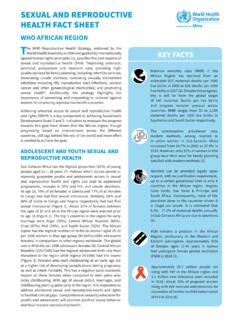Transcription of Reproductive Tract Infections
1 ReproductiveTract Infections Reproductive Health Epidemiology Series Module 3 2003 Department of Health and Human Services Reproductive Tract Infections Reproductive HEALTH EPIDEMIOLOGY SERIES: MODULE 3 June 2003 The United States Agency for International Development (USAID) provided funding for this project through a Participating Agency Service Agreement with CDC ( ). Reproductive HEALTH EPIDEMIOLOGY SERIES MODULE 3 Reproductive Tract Infections Divya A. Patel, MPH Nancy M. Burnett, BS Kathryn M. Curtis, PhD Technical Editors Susan Hillis, PhD Polly Marchbanks, PhD Department of Health and Human Services Centers for Disease Control and Prevention National Center for Chronic Disease Prevention and Health Promotion Division of Reproductive Health Atlanta, Georgia, 2003 CONTENTS Learning Objectives.
2 1 Overview of Reproductive Tract Infections (RTIs) ..3 Prevalence of RTIs ..3 What Are the Most Commonly Occurring RTIs in Developing Countries? ..4 Sequelae of Untreated RTIs ..4 How Are RTIs Transmitted? ..7 How Are RTIs and Their Sequelae Linked With Key Health-Related Development Programs?..8 General Model of the Epidemiology of RTIs ..13 How Is the Spread of RTIs Measured?..13 Efficiency of Transmission ( ) ..14 Effective Mean Rate of Sexual Partner Change (c)..14 Duration of Infectiousness (D) ..15 How Is the Model of Transmission Dynamics Applied?..15 Long-Term Outcome Indicators for STDs and RTIs ..17 RTI Prevalence in a Defined Target Infertility ..18 STD/HIV-Related Cause-Specific Mortality Rate ..19 Rate of Congenital Syphilis or Ophthalmia Surveillance for What Are Some Issues in Surveillance of RTIs?
3 25 Laboratory-Based Surveillance ..25 Is There an Alternative to Laboratory-Based Surveillance in Resource-Poor Settings? ..26 Issues in Monitoring Progress Toward the Reduction of RTIs ..27 General Model as Framework for Strategic Planning for Control and Prevention of RTIs ..29 Prevention of RTIs ..30 How Do Strategies for the Control and Prevention of Viral and Bacterial RTIs Differ?..31 Implications of Research and Uses of Collected How Are Surveillance Data Used?..33 Who Needs to Know the Results of the Research, and Why? ..33 How Can We Tell Whether an RTI Control Program Is Achieving Its Goals? ..34 Resources ..37 Case Studies I. Epidemiology of STDs: Outbreak Investigation ..39 II. Epidemiology of STDs: Questionnaire Exercise.
4 51 Appendices A. Overview of Common RTIs and STDs ..65 B. Evaluating Diagnostic Tests ..75 References ..81 Module 3: Reproductive Tract Infections Reproductive Tract Infections LEARNING OBJECTIVES This module is designed for Reproductive health professionals inter ested in conducting surveillance and epidemiologic studies related to Reproductive Tract Infections (RTIs) and who need a working knowledge of epidemiologic and analytic issues specific to RTIs. After studying the material in this module, the student should be able to: Identify the major viral and bacterial RTIs and their sequelae. Describe the interaction between Reproductive Tract Infections and family planning, child survival, safe motherhood, and HIV prevention. Understand the general model for the spread of infection and its implications in the control and prevention of RTIs.
5 Translate the general model for the spread of infection into practical biologic and behavioral determinants of the spread of infection. Describe how data from surveillance systems and epidemiologic studies can be linked to public health action to reduce the burden of RTIs. Understand the major epidemiologic and analytic issues specific to RTIs. Describe the uses of research and collected data, including the dissemination of findings. 1 Reproductive Health Epidemiology Series Case Study: Reproductive Tract Infections Ethiopia The prevalence of Reproductive Tract Infections (RTIs) in Ethiopia is among the highest in Africa. Despite a decrease in the prevalence of syphilis since the 1960s due to increased use of antibiotics, the number of cases of gonorrhea, chancroid, and lymphogranuloma venereum reported to the Ministry of Health increased three to five times between 1983 and 1990.
6 Recognizing the cultural, social, and economic barriers for women attending sexually transmitted disease (STD) clinics in the face of this growing public health problem, researchers became interested in exploring possibilities for interventions in health services routinely attended by Ethiopian women. A study was conducted among 542 women attending family planning clinics (FPCs) and 1,569 women attending gynecological outpatient departments (GOPDs) to examine the socioeconomic and cultural context of family planning and to determine the prevalence of certain RTIs, pelvic inflammatory disease (PID), and cervical cancer among both groups of women. A full abdominal and gynecological examination, along with a questionnaire soliciting detailed demographic and lifestyle information, was administered to each woman in the study.
7 Clinical examinations revealed that, although women attending FPCs had fewer symptoms than those attending GOPDs, they had more clinical evidence of past and present PID and more active Infections requiring immediate treatment. Serological testing revealed that these women also had more evidence of exposure to STDs with higher titers indicative of active or present infection. Of particular concern, only 4% of women attending FPCs had no serological evidence of RTIs, and 64% had serological evidence of three or more different Infections . Use of FPC services was found to be associated with higher levels of income and education; therefore, broadening educational opportunities for girls and women should increase acceptance of FPC services and bring about more opportunities for detection, treatment, and prevention of RTIs.
8 A significant implication of this study is that targeting women who attend FPCs for epidemiologic studies and control and prevention programs is an effective way to reach women who, for various reasons, may not attend STD clinics. The FPC visit provides an opportunity for screening women who are particularly at risk for infection and for educating women about modes of STD transmission and prevention of future infection. When treatment for RTIs can be offered in the FPC, women are not required to make separate visits to other primary health centers for care. On the basis of studies such as this one, adequate screening, treatment, and education of women attending FPCs and their partners should be considered as ways of easing the burden of RTIs in the community.
9 Adapted from: Duncan ME,Tibaux G, Kloos H, et al. STDs in women attending family planning clinics: a case study in Addis Ababa. Soc Sci Med 1997;44(4):441 54. 2 Module 3: Reproductive Tract Infections OVERVIEW OF Reproductive Tract Infections Reproductive Tract Infections (RTIs) include three types of infection: 1) sexually transmitted diseases (STDs), such as chlamydia, gonorrhea, chancroid, and human immunodeficiency virus (HIV); 2) endogenous Infections , which are caused by overgrowth of organisms normally present in the genital Tract of healthy women, such as bacterial vaginosis or vulvovaginal candidiasis; and 3) iatrogenic Infections , which are associated with improperly performed medical procedures such as unsafe abortion or poor delivery practices (1).
10 RTIs are preventable, and many are treatable as well. The burden of untreated RTIs is especially heavy for women because these Infections are often asymptomatic or the symptoms are not recognizable. Morbidity and mortality related to RTIs deprive society of important contributions made by women in terms of economic, social, and cultural development. Although RTIs affect women in both developing and industrialized countries, the Infections and their sequelae are an especially urgent public health problem in resource-poor areas around the world. Demographic changes in developing countries have led to a dramatic increase in the number of adolescent and young adult women and men in their most sexually active years, which translates into a greater proportion of the population at risk for RTIs.












![Male & Female Reproductive System.ppt [Read-Only]](/cache/preview/1/0/5/2/c/b/a/1/thumb-1052cba1e7f4d30ac6736a0f525d004c.jpg)



